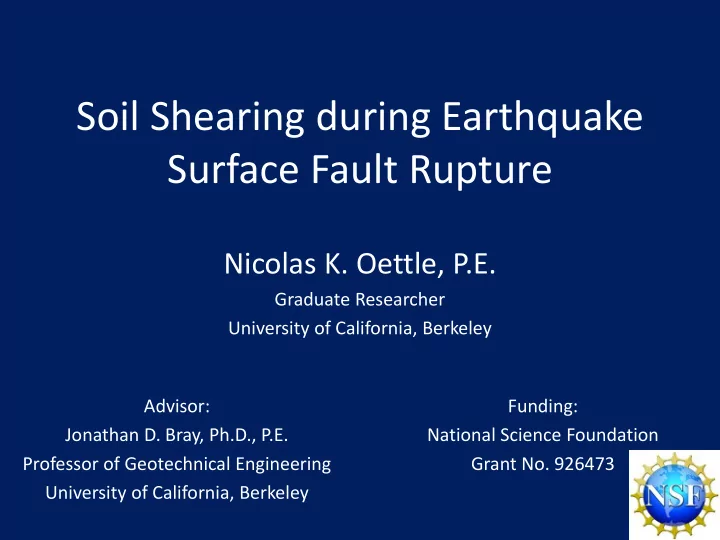

Soil Shearing during Earthquake Surface Fault Rupture Nicolas K. Oettle, P.E. Graduate Researcher University of California, Berkeley Advisor: Funding: Jonathan D. Bray, Ph.D., P.E. National Science Foundation Professor of Geotechnical Engineering Grant No. 926473 University of California, Berkeley
Surface Fault Rupture Through Soil • Important for buildings, overpasses, railroads • Centrifuge tests (Univ. of Dundee): :: (Bransby et al., 2008)
Centrifuge Incremental Surface Response • Response localizes with increasing displacement 0.30 Incremental Vertical Displacement (m) 0.25 0.20 Footwall Hanging Wall 0.15 0.10 0.05 0.00 35 37 39 41 43 45 47 49 51 53 55 Original Horizontal Position (m) 0-0.3 m 0.6-0.9 m 2.1-2.4 m Reverse Fault
Why does Localization Occur? • Numerical analysis with FLAC • Shear band formation and alteration of K 0 stress Zone of High Stress Ratio Surface Deformation Principal Stresses Fault Movement
What if Past Earthquakes have Already Ruptured the Soil? • Current research does not address this • Fault rupture may already be localized • Weakened shear zone likely remains intact • Initial stress state partially intact • Stress relaxation • Correct initial stress unknown :: (Lade et al., 2010)
Centrifuge Test w/ Prior Rupture • Assumed continuation of prior EQ in FLAC • Ignores stress relaxation Angular Distortion Surface Displacement 0.7 Original Horizontal Position (m) Vertical Displacement at Surface (m) 30 35 40 45 50 55 60 0.6 1/5 0.5 Ruptured Unruptured Angular Distortion (m/m) Unruptured Soil Soil 0.4 Soil 1/50 0.3 0.2 1/500 0.1 Ruptured 0.0 Soil 30 35 40 45 50 55 60 1/5000 Original Horizontal Position (m)
Potential Effect of Stress Relaxation • Significant, but shear band also important • Reality probably in between ruptured/unruptured 0.30 Vertical Displacement at Surface (m) Ruptured Soil (ss-ls) 0.25 0.20 Ruptured Soil (stress reset) 0.15 Ruptured Soil Unruptured (no strain softening) Soil (ls) 0.10 0.05 0.00 10 15 20 25 30 Original Horizontal Position (m)
Prior Displacement Required to Localize? • Based on a number of FLAC analyses • Depends on soil height, failure strain, fault type 12% 10% Vertical Fault Movement to Soil Thickness (m/m) Solid-Reverse Faults 8% 6% 4% Dashed-Normal Faults 2% 0% Compression 0% 5% 10% 15% PS Compression (loading) Failure Strain
Why Normal/Reverse Different? • Result of stress path Reverse: Stress Paths: Zone of High Stress Ratio Surface Deformation 100 Critical Shear Normal State Band Fault Stress Ratio 50 Plane Strain Extension Loading Initial Stress 0 t=( σ 1 - σ 3 )/2 (kPa) Principal Stresses Fault Movement Reverse Fault Normal: -50 Surface Deformation Graben Zone of High Stress Ratio Zone of High Stress Ratio -100 Plane Strain Compression Shear Band Peak Unloading Stress Ratio -150 Shear Band 0 50 100 150 200 Principal Stresses s=( σ 1 + σ 3 )/2 (kPa) Fault Movement
Effect of Field Stress Path • Controlled by field stress path failure strain 12% 8% 7% 10% Vertical Fault Movement Vertical Fault Movement to Soil Thickness (m/m) to Soil Thickness (m/m) Solid-Reverse Faults 6% 8% 5% 6% 4% 3% 4% Solid-Reverse Faults 2% Dashed-Normal Faults Dashed-Normal Faults 2% 1% 0% 0% 0% 5% 10% 15% 0% 5% 10% 15% 20% PS Compression (loading) Failure Strain Field Stress Path Failure Strain
Three Conclusions 1. Past earthquakes could significantly affect fault rupture through soil 2. Caused by shear banding and stress development – Correct initial stress unknown (stress relaxation) 3. Normal faults more easily influenced than reverse Result of field stress path –
Recommend
More recommend